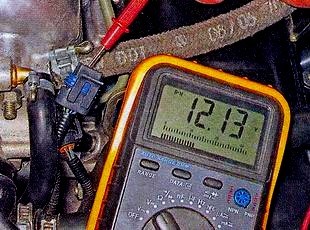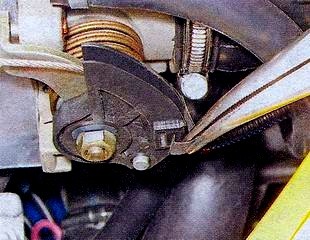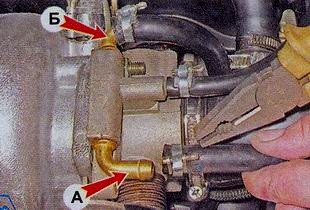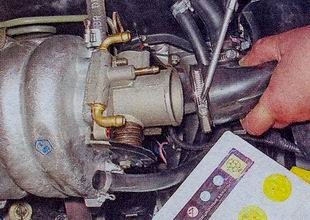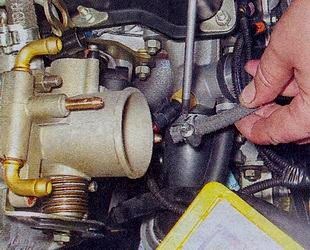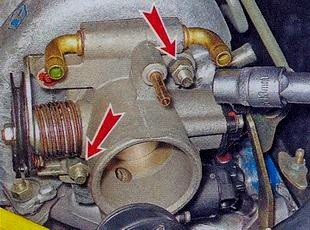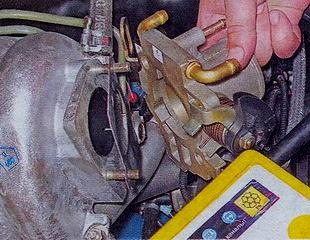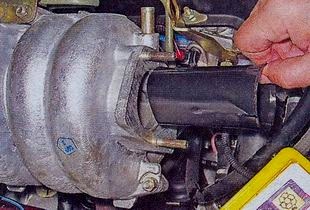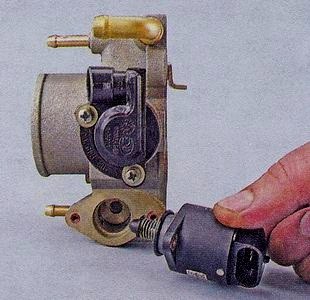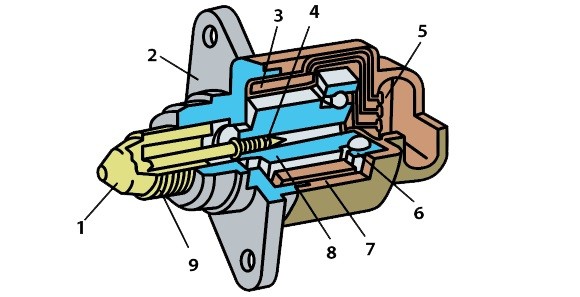
Everything you need to know about the idle speed controller (sensor) VAZ 2107
Content
Violations in the operation of the VAZ 2107 engine at idle are a fairly common phenomenon. And if we are talking about a power unit with distributed injection, then very often the cause of such problems is a malfunction of the idle speed controller (IAC). We will talk about it in this article.
Idle speed regulator (sensor) VAZ 2107
In everyday life, IAC is called a sensor, although it is not one. The fact is that sensors are measuring equipment, and regulators are executive equipment. In other words, it does not collect information, but executes commands.
Purpose
IAC is a node of the engine power supply system with distributed injection, which regulates the amount of air entering the intake manifold (receiver) when the throttle is closed. In fact, this is a conventional valve that slightly opens the spare (bypass) air channel by a predetermined amount.
IAC device
The idle speed controller is a stepping motor, consisting of a stator with two windings, a magnetic rotor and a rod with a spring-loaded valve (locking tip). When voltage is applied to the first winding, the rotor rotates through a certain angle. When it is fed to another winding, it repeats its movement. Due to the fact that the rod has a thread on its surface, when the rotor rotates, it moves back and forth. For one complete revolution of the rotor, the rod makes several "steps", moving the tip.

Operating principle
The operation of the device is controlled by an electronic unit (controller). When the ignition is turned off, the IAC rod is pushed forward as far as possible, due to which the bypass channel through hole is completely blocked, and no air enters the receiver at all.
When the power unit is started, the electronic controller, focusing on the data coming from the temperature and crankshaft speed sensors, supplies a certain voltage to the regulator, which, in turn, slightly opens the flow section of the bypass channel. As the power unit heats up and its speed decreases, the electronic unit through the IAC reduces the flow of air into the manifold, stabilizing the operation of the power unit at idle.
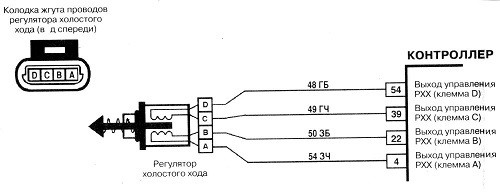
When we press the accelerator pedal, the air enters the receiver through the main channel of the throttle assembly. The bypass channel is blocked. To correctly determine the number of "steps" of the device's electric motor, the electronic unit additionally uses information from sensors for throttle position, air flow, crankshaft position and speed.
In the event of an additional load on the engine (turning on the fans of the radiator, heater, air conditioner, heated rear window), the controller opens a spare air channel through the regulator to maintain the power of the power unit, prevent dips and jerks.
Where is the idle speed regulator on the VAZ 2107
The IAC is located in the throttle body. The assembly itself is attached to the rear of the engine intake manifold. The location of the regulator can be determined by the wiring harness that fits to its connector.
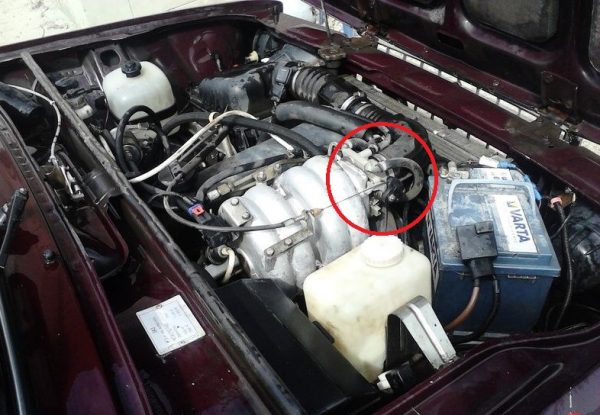
Idle speed regulation in carburetor engines
In VAZ 2107 carburetor power units, idling is provided with the help of an economizer, the actuating unit of which is a solenoid valve. The valve is installed in the carburetor body and is controlled by a special electronic unit. The latter receives data on the number of engine revolutions from the ignition coil, as well as on the position of the throttle valve of the primary chamber of the carburetor from the contacts of the fuel quantity screw. Having processed them, the unit applies voltage to the valve, or turns it off. The design of the solenoid valve is based on an electromagnet with a locking needle that opens (closes) a hole in the idle fuel jet.
IAC malfunction symptoms
Signs that the idle speed controller is out of order can be:
- unstable idling (engine troit, stalls when the accelerator pedal is released);
- decrease or increase in the number of engine revolutions at idle (floating revolutions);
- a decrease in the power characteristics of the power unit, especially with an additional load (turning on the fans of the heater, radiator, rear window heating, high beam, etc.);
- complicated start of the engine (the engine starts only when you press the gas pedal).
But here it should be borne in mind that similar symptoms may also be inherent in malfunctions of other sensors, for example, sensors for throttle position, mass air flow, or crankshaft position. In addition, in the event of a malfunction of the IAC, the “CHECK ENGINE” control lamp on the panel does not light up, and it will not work to read the engine error code. There is only one way out - a thorough check of the device.
Checking the electrical circuit of the idle speed controller
Before proceeding to the diagnosis of the regulator itself, it is necessary to check its circuit, because the reason that it stopped working may be a simple wire break or a malfunction of the electronic control unit. To diagnose the circuit, you only need a multimeter with the ability to measure voltage. The procedure is as follows:
- We raise the hood, we find the sensor wiring harness on the throttle assembly.
- Disconnect the wiring harness block.
 Each of the IAC pins is marked
Each of the IAC pins is marked - We turn on the ignition.
- We turn on the multimeter in the voltmeter mode with a measurement range of 0–20 V.
- We connect the negative probe of the device to the mass of the car, and the positive one in turn to the terminals "A" and "D" on the block of the wiring harness.
 The voltage between ground and terminals A, D should be approximately 12 V
The voltage between ground and terminals A, D should be approximately 12 V
The voltage between the ground and each of the terminals must correspond to the voltage of the on-board network, i.e., approximately 12 V. If it is less than this indicator, or it does not exist at all, it is necessary to diagnose the wiring and the electronic control unit.
Diagnostics, repair and replacement of the idle speed regulator
To check and replace the regulator itself, you will need to dismantle the throttle assembly and disconnect the device from it. From the tools and means will be needed:
- screwdriver with a cross-shaped bit;
- slotted screwdriver;
- round pliers;
- socket wrench or head for 13;
- multimeter with the ability to measure resistance;
- caliper (you can use a ruler);
- clean dry cloth;
- topping up coolant (maximum 500 ml).
Dismantling of the throttle assembly and removal of the IAC
To remove the throttle assembly, you must:
- Raise the hood, disconnect the negative cable from the battery.
- Using a slotted screwdriver, hook the end of the throttle cable and remove it from the "finger" of the gas pedal.
- On the throttle block, use round-nose pliers to disconnect the retainer on the throttle actuator sector.
 The latch is detached using round-nose pliers or a screwdriver
The latch is detached using round-nose pliers or a screwdriver - Turn the sector counterclockwise and disconnect the cable end from it.
 To disconnect the tip, you need to turn the drive sector counterclockwise
To disconnect the tip, you need to turn the drive sector counterclockwise - Remove the plastic cap from the cable end.
- Using two 13 wrenches, loosen the cable fastening on the bracket.
 Loosen the cable by loosening both nuts.
Loosen the cable by loosening both nuts. - Pull cable out of bracket slot.
 To remove the cable, it must be removed from the slot of the bracket
To remove the cable, it must be removed from the slot of the bracket - Disconnect the wire blocks from the IAC connectors and the throttle position sensor.
- Using a screwdriver with a Phillips bit or round-nose pliers (depending on the type of clamps), loosen the clamps on the coolant inlet and outlet fittings. Remove clamps. In this case, a small amount of liquid may leak out. Wipe it off with a dry, clean cloth.
 Clamps can be loosened with a screwdriver or pliers (round-nose pliers)
Clamps can be loosened with a screwdriver or pliers (round-nose pliers) - In the same way, loosen the clamp and remove the hose from the crankcase ventilation fitting.
 The crankcase ventilation fitting is located between the coolant inlet and outlet fittings
The crankcase ventilation fitting is located between the coolant inlet and outlet fittings - Use a Phillips screwdriver to loosen the clamp on the air inlet. Remove the pipe from the throttle body.
 The air inlet is fixed with a worm clamp
The air inlet is fixed with a worm clamp - Similarly, loosen the clamp and remove the hose for removing fuel vapors from the fitting on the throttle assembly.
 To remove the fuel vapor hose, loosen the clamp
To remove the fuel vapor hose, loosen the clamp - Using a socket wrench or a 13 socket, unscrew the nuts (2 pcs) securing the throttle assembly to the intake manifold.
 The throttle assembly is attached to the manifold with two studs with nuts.
The throttle assembly is attached to the manifold with two studs with nuts. - Remove the throttle body from the manifold studs along with the sealing gasket.
 A sealing gasket is installed between the throttle assembly and the manifold
A sealing gasket is installed between the throttle assembly and the manifold - Remove the plastic sleeve from the manifold that sets the configuration of the air flow.
 The plastic sleeve defines the configuration of the airflow inside the manifold
The plastic sleeve defines the configuration of the airflow inside the manifold - Using a Phillips screwdriver, remove the two screws securing the regulator to the throttle body.
 The regulator is attached to the throttle body with two screws.
The regulator is attached to the throttle body with two screws. - Carefully remove the regulator, being careful not to damage the rubber o-ring.
 A sealing rubber ring is installed at the junction of the IAC with the throttle assembly
A sealing rubber ring is installed at the junction of the IAC with the throttle assembly
Video: removing and cleaning the throttle assembly on the VAZ 2107
How to check the idle speed control
To check the IAC, do the following:
- Turn on the multimeter in ohmmeter mode with a measurement range of 0–200 ohms.
- Connect the probes of the device to the terminals A and B of the regulator. Measure resistance. Repeat measurements for pins C and D. For a working regulator, the resistance between the indicated pins should be 50–53 ohms.

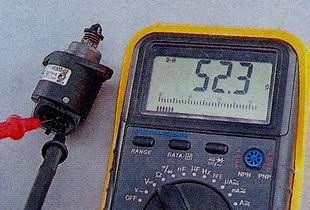 Resistance between adjacent paired pins should be 50-53 ohms
Resistance between adjacent paired pins should be 50-53 ohms - Switch the device to the resistance measurement mode with the maximum limit. Measure the resistance between contacts A and C, and after B and D. The resistance in both cases should tend to infinity.
- Using a vernier caliper, measure the protrusion of the shut-off rod of the regulator in relation to the mounting plane. It should be no more than 23 mm. If it is greater than this indicator, adjust the position of the rod. To do this, connect one wire (from the positive terminal of the battery) to terminal D, and briefly connect the other (from ground) to terminal C, simulating a pulsed voltage supply from the electronic control unit. When the rod reaches the maximum overhang, repeat the measurements.
If the resistance value between the listed outputs does not correspond to the specified indicators, or the rod overhang is more than 23 mm, the idle speed regulator must be replaced. There is no point in trying to repair the device. In the event of an open or short circuit in the stator windings, and it is these faults that cause a change in the resistance at the terminals, the regulator cannot be restored.
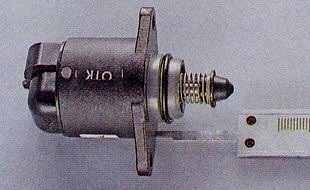

Cleaning the idle speed regulator
If the resistance is normal and everything is in order with the length of the rod, but it does not move after the voltage is connected, you can try to clean the device. The problem may be the jamming of the worm mechanism, due to which the stem moves. For cleaning, you can use a rust-fighting fluid such as WD-40 or its equivalent.
Fluid is applied to the stem itself where it enters the regulator body. But do not overdo it: you do not need to pour the product into the device. After half an hour, grab the stem and gently twist it from side to side. After that, check its performance by connecting the wires from the battery to terminals D and C, as described above. If the regulator stem began to move, the device can be used again.
Video: cleaning RXX


Watch this video on YouTube
How to choose an IAC
When buying a new regulator, it is recommended to pay special attention to the manufacturer, because the quality of the part, and, consequently, its service life, depends on it. In Russia, idle speed regulators for VAZ injection cars are produced under catalog number 21203–1148300. These products are almost universal, as they are suitable for the “sevens”, and for all “Samaras”, and for representatives of the VAZ of the tenth family.
The VAZ 2107 left the assembly line with standard regulators manufactured by Pegas OJSC (Kostroma) and KZTA (Kaluga). IAC produced by KZTA today are considered the most reliable and durable. The cost of such a part is on average 450-600 rubles.
Installing a new idle speed regulator
To install a new IAC, you must:
- Coat the O-ring with a thin layer of engine oil.
- Install the IAC into the throttle body, fix it with two screws.
- Install the assembled throttle assembly on the manifold studs, secure it with nuts.
- Connect the main hoses for the coolant, crankcase ventilation and fuel vapor removal. Secure them with clamps.
- Put on and fix the air pipe with a clamp.
- Connect the wire blocks to the regulator and the throttle position sensor.
- Connect the throttle cable.
- Check coolant level and top up if necessary.
- Connect the battery and check the operation of the motor.
As you can see, there is nothing complicated either in the device or in the process of checking and replacing the idle speed controller. In the event of a malfunction, you can easily solve this problem without outside help.



